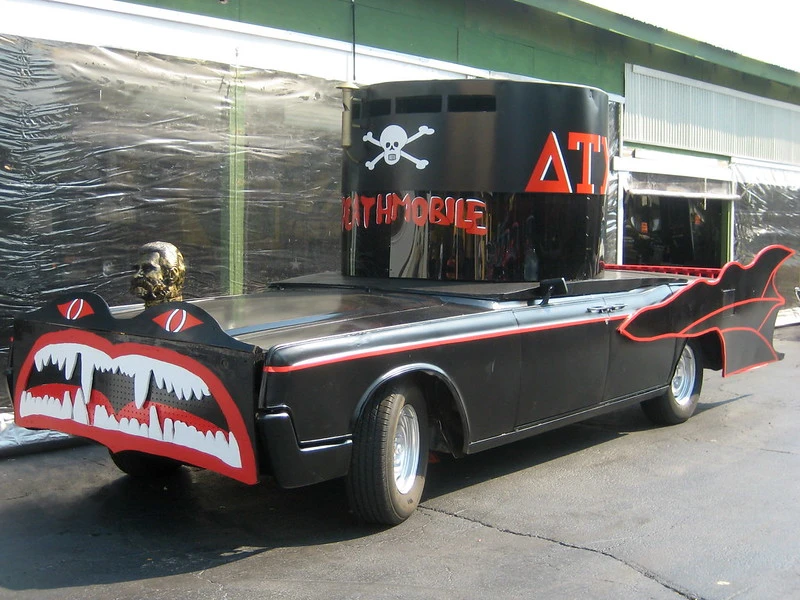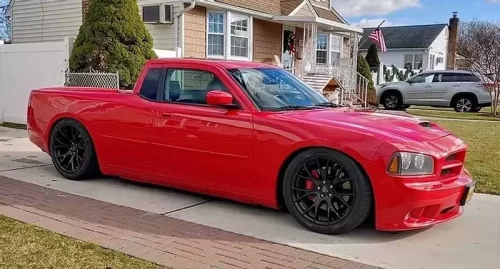
FAST FACTS Vol. 1, Issue 49 – Scrooged
T’was Christmas Eve In New York City THIS HOLIDAY CLASSIC FILM FEATURES A 1970 CHECKER MARATHON SEDAN TAXICAB. Scrooged – Featuring a 1970 Checker Marathon Cab

Of course, we’re eluding to the 1978 runaway-hit National Lampoon’s Animal House, and Faber College, Delta Tau Chi fraternity pledge Flounder (Stephen Furst) brother’s 1966 black Lincoln Continental, powered by a 430ci MEL engine with a twin-range Turbo Drive Lincoln transmission.
After a typical Delta frat-boys excursion of beer-drenched driving, an all-girls college pitstop, and a side-swiping exodus from a roadhouse, the pristine Lincoln is basically trashed, and thus ingeniously reincarnated as the Deathmobile.
The Deathmobile started its life as a sleek black 1966 Lincoln Continental that was summarily converted into one of the greatest parade-crashers of all time by famed Hollywood car customizer George Barris, who also created the Batmobile.
For the homecoming parade, the ominous Deathmobile was disguised in a beautiful birthday cake, adorned with the loveable 50’s-appropriate phrase “Eat Me” on the side, The Deathmobile was forged by the Delta house brothers for the express goal of sealing their expulsion with the vengeful ramming Dean Wormer’s judging stand.
The character Otter, played by actor Tim Matheson, demanded to be in the Deathmobile for the parade scenes, even though there was absolutely no cinematic benefit to being in the shots. “I just needed to be in that vehicle.” He noted. Matheson shared that seeing out of the Deathmobile was virtually impossible, and stunt driver Bud Ekins, earned his money driving the crazy thing. Matheson goes on to say he was literally “hanging on for dear life”, as stunt driver Ekins blurts out “I can’t see a damn thing”, and guns the gas pedal for “ramming speed”, and crashes into the flimsy, but solid-enough, wooden bleacher stands.
Amusingly, the Lincoln was much harder to destroy than the production crew anticipated. For the pre-parade scene, they had to use a heavy-equipment skip loader to bang up the front and rear of the car enough for it to register on the screen. And, in the final scenes, they brought in a backhoe to gradually dent and pierce the Deathmobile so the damage could be “clearly seen” on screen. Creator George Barris referred to the car as being “consumed” in the movie’s closing scenes. Props to Lincoln for making ‘real’ sturdy cars back then.
Want to own the original Deathmobile? It was auctioned for less than $20,000 in 2009. We’re sure you can get it for an Otis Redding song.
If you want to trick out a vintage Lincoln Continental, or Deathmobile, of your own, bolt in a world-class FRASER remanufactured engine and get that bad boy up to ramming speed!

T’was Christmas Eve In New York City THIS HOLIDAY CLASSIC FILM FEATURES A 1970 CHECKER MARATHON SEDAN TAXICAB. Scrooged – Featuring a 1970 Checker Marathon Cab

Issue 35 • Engine & Transmission Tips Still one of Ford’s strongest and Fraser’s most sought-after remanufactured engines In this article, we want to pay

More than just a vehicle, the Jeep Wrangler is your ultimate companion for any adventure. The Wrangler, paired with dependable engines like the Jeep 3.8L

Issue 31 • Engine & Transmission Tips Undercoating your vehicle. Is it worth it? And, can you do it yourself? If you have a new

Part 1 – The Dodge Charger Pickup Conversion Kit cars are an affordable, totally unique, and great winter project! Project: Convert a 2005-2010 Dodge Charger

Issue 17 • Engine & Transmission Tip You Can Do A LOT To Protect and Preserve Your Windshield and Wipers Nobody Likes Bug Splatter. Bleck!